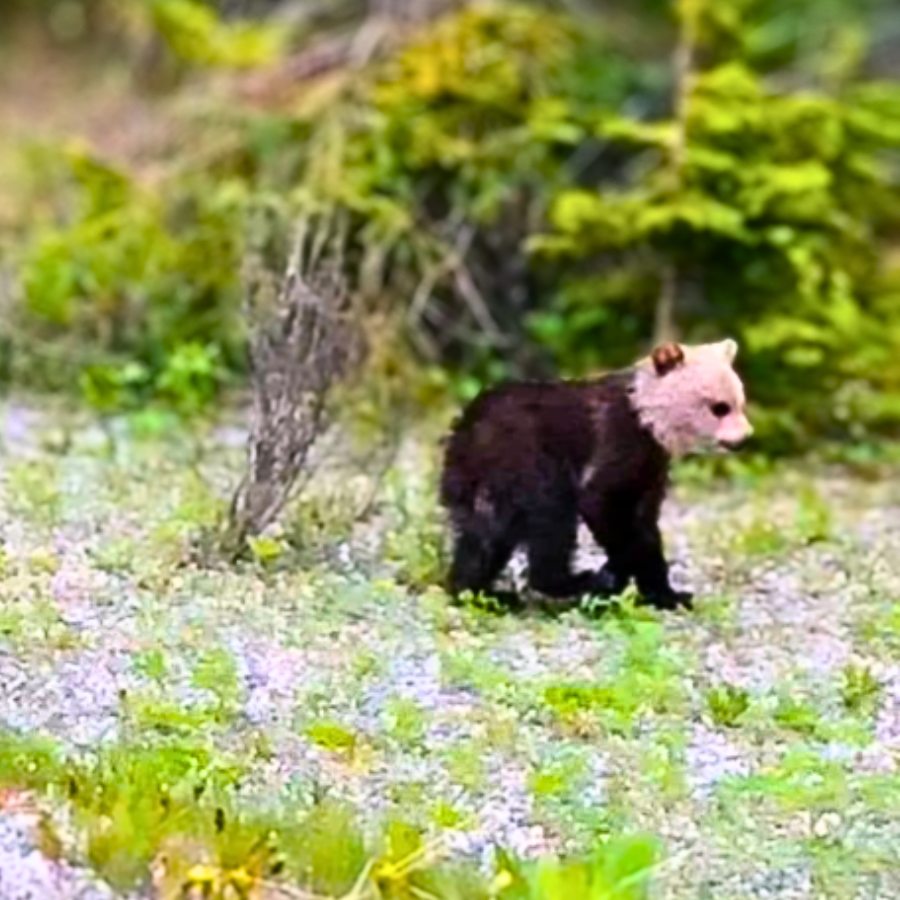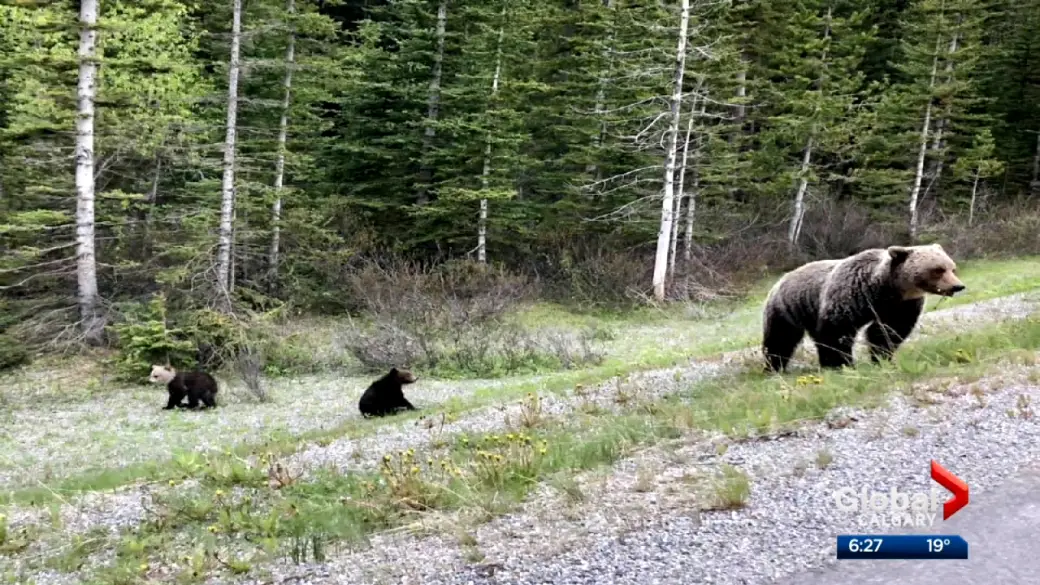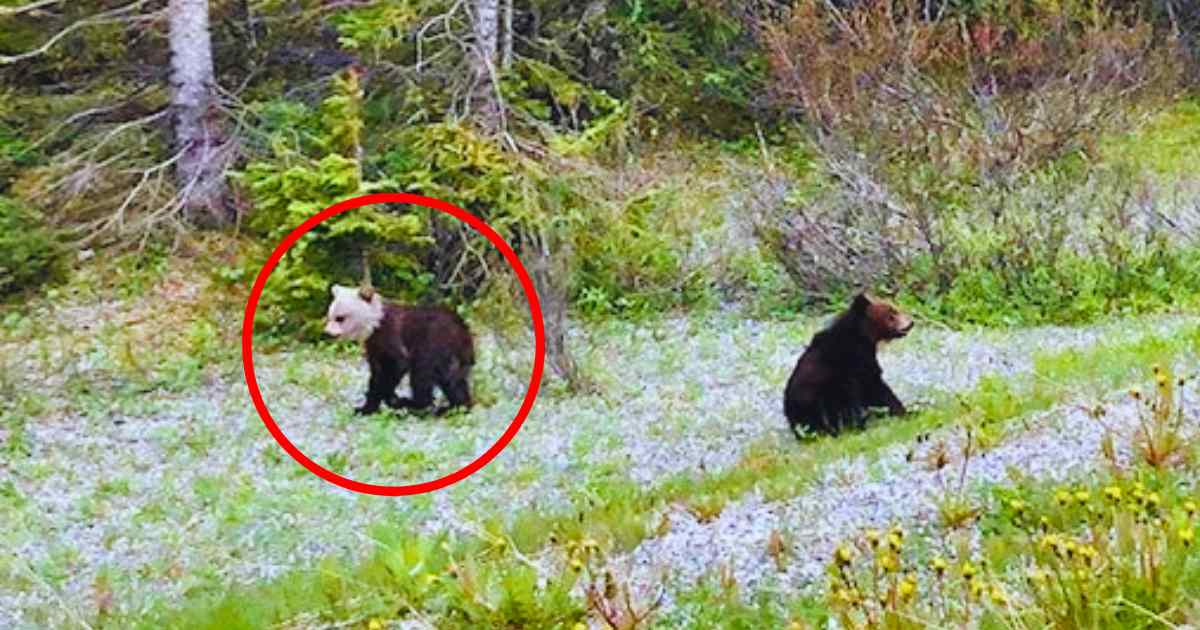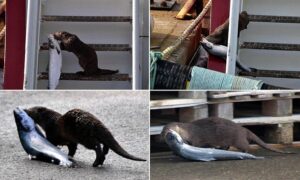It started as a simple drive home — and turned into one of Canada’s most remarkable rare wildlife sightings in recent years.
While passing through the Banff National Park region, Calgary resident Julia Turner Butterwick and her family noticed a small grizzly cub walking beside its mother. Nothing unusual at first glance — until sunlight caught its head.
White. Completely white.
The rest of the cub’s body was the rich brown typical of grizzlies, but its head looked dipped in snow.
“I said to my husband, ‘That cub has a white head,’” Turner Butterwick recalled. “When I zoomed in on my photo, I realized it wasn’t a trick of the light — the entire head was white, and the body was brown. I’ve never seen anything like it.”

A Once-in-a-Lifetime Sighting
The family had already seen several bears that day — four black bears and three grizzlies — but this one stopped them in their tracks.
“That little guy is pretty special,” Turner Butterwick said.
Experts agree. Several bear biologists and conservationists confirmed the cub was indeed a grizzly, but none had ever seen or even heard of such coloration.
“I’ve never seen anything like it, nor a photo of one,” said Jeff Gailus, a wildlife writer and grizzly expert. “It’s extraordinary — perhaps even rarer than the all-white grizzly that’s been seen in Banff.”
Read next: The Girl Who Came Back After 15 Months – A Story of Courage and Community
Nature’s Genetic Surprise
Wildlife expert Paul Pauquet called it an “exceptionally unique” find, possibly never before documented.
He explained that such unusual coloring likely comes from a recessive gene, present in both parents but not visible unless inherited twice.
“In theory, the gene could be carried by the mother and father without showing up in either,” Pauquet said. “The fact that it appeared in this cub — and possibly others nearby — suggests some genetic isolation within this population.”
That isolation might stem from geography. In smaller or more contained populations, the odds of related bears breeding rise, increasing the chance of rare genes expressing themselves.
“This could indicate that some Banff-area grizzlies are becoming more genetically distinct,” Pauquet added.

Two White Bears, One Spring
The white-headed cub isn’t alone in turning heads this year.
Only weeks earlier, locals spotted a completely white grizzly nicknamed Nakota, now famous across Alberta. Nakota’s striking color isn’t albinism, but a natural color-phase variation that gives her ivory fur.
“To have two such sightings in one season is nothing short of a miracle,” said Gailus. “Unless that cub got into a can of paint, we’re witnessing a truly rare genetic phase — maybe even rarer than Nakota herself.”
Both the snow-white cub and Nakota have drawn attention from photographers and tourists — and that, experts warn, comes with risks.
“Public curiosity can unintentionally endanger the bears,” Parks Canada said in a statement. “When people stop or approach for photos, it can habituate wildlife to vehicles and roads, increasing the chance of collisions.”
Also Read: The Whale That Saved a Diver from a Giant Tiger Shark – An Ocean Miracle
Parks Canada Steps In
Parks Canada confirmed it is aware of the unique cub and is monitoring the small family group, which roams between Banff and Kootenay National Parks.
“The mother, identified as female grizzly 143, is known to us,” the agency said. “Her cubs are believed to be about six months old — their first season in the wild with their mother.”
The agency noted that grizzly 143 has a sibling, female grizzly 142, who resides near Lake Louise. Neither bear wears a radio collar, which indicates they typically avoid high-traffic human areas.
While the agency has not released the exact location — to protect the family — they did confirm the cub’s head and chest appear “blond or white.”
A Reminder to Keep Distance
As enchanting as these rare wildlife sightings can be, officials emphasize that admiration should always happen from afar.
“When you see wildlife near roadways, stay in your vehicle and maintain distance,” Parks Canada urged. “Do not approach or feed wild animals. Habituated bears are more likely to be struck by vehicles or need relocation.”
For Turner Butterwick, the encounter was enough from behind the car window.
“It was one of those moments where you realize how wild and mysterious this country still is,” she said. “We just felt lucky to witness it — no need to get closer.”
When Science Meets Wonder
Experts are now studying whether this cub’s unusual look connects genetically to Nakota, the other white bear in the region.
Regardless of the outcome, both animals represent a vivid symbol of how life finds new expressions — even in populations long monitored by science.
And for everyday Canadians, they’re a reminder that wilderness still holds surprises that no camera trap or DNA sequence can predict.
A Glimpse into Nature’s Creativity
In a world of data and routine, moments like this cut through the noise. A single cub with a snow-white head wandering through Alberta’s forests — a flash of contrast that makes even seasoned researchers pause.
Maybe it’s genetics. Maybe it’s chance. Or maybe it’s simply nature showing off.
Whatever the reason, this young bear has already earned its place among Canada’s most unforgettable rare wildlife sightings — proof that even in a mapped and measured world, wonder still roams free.



